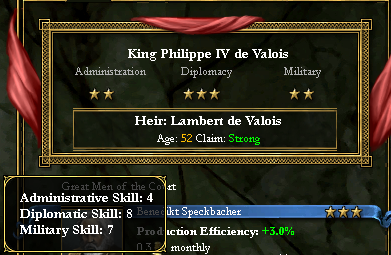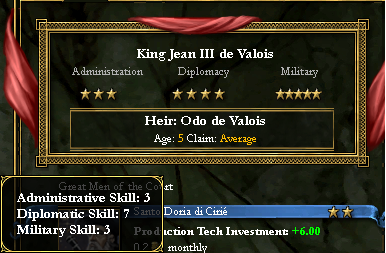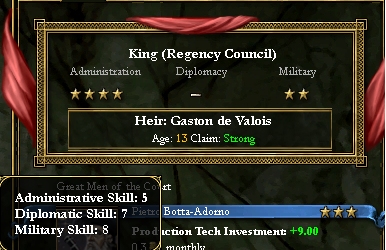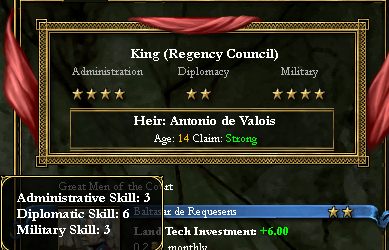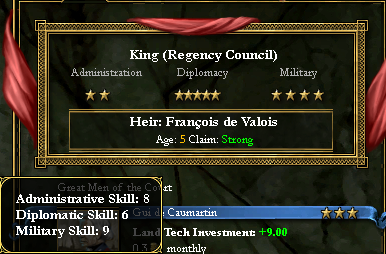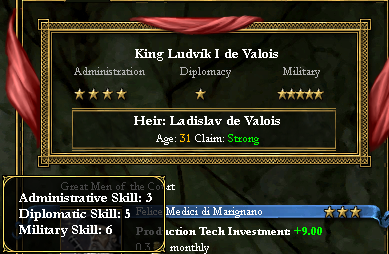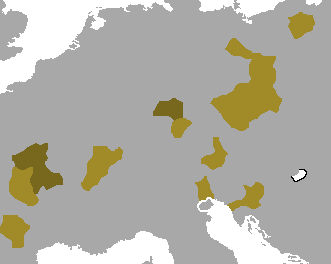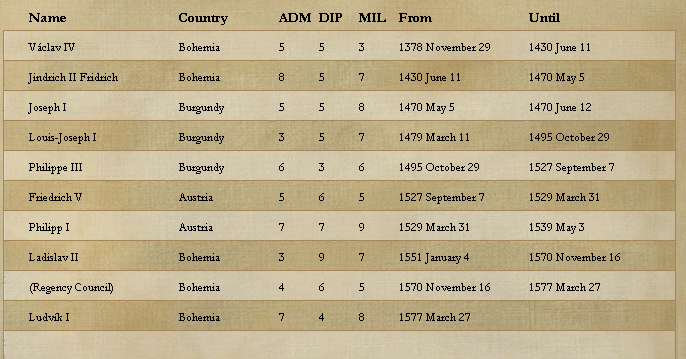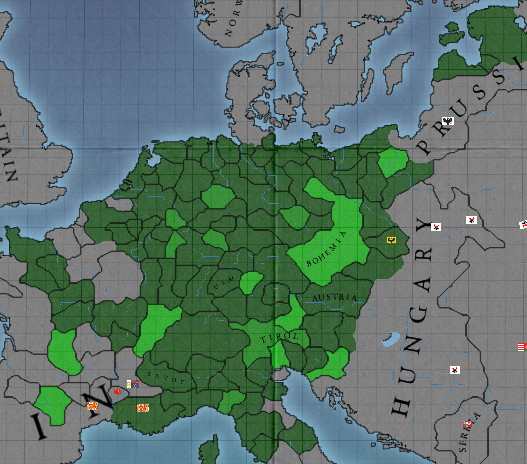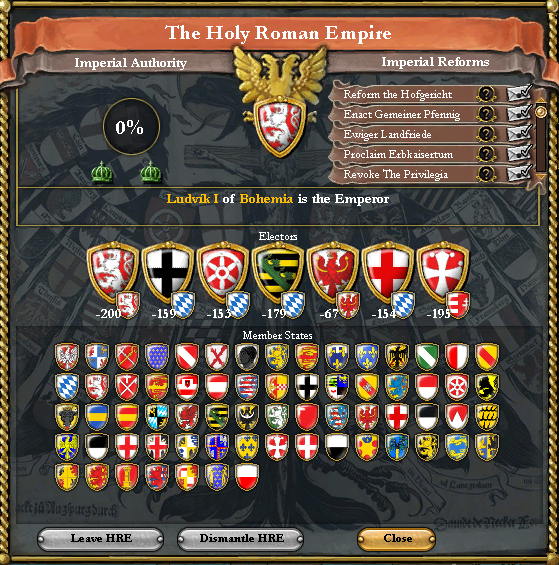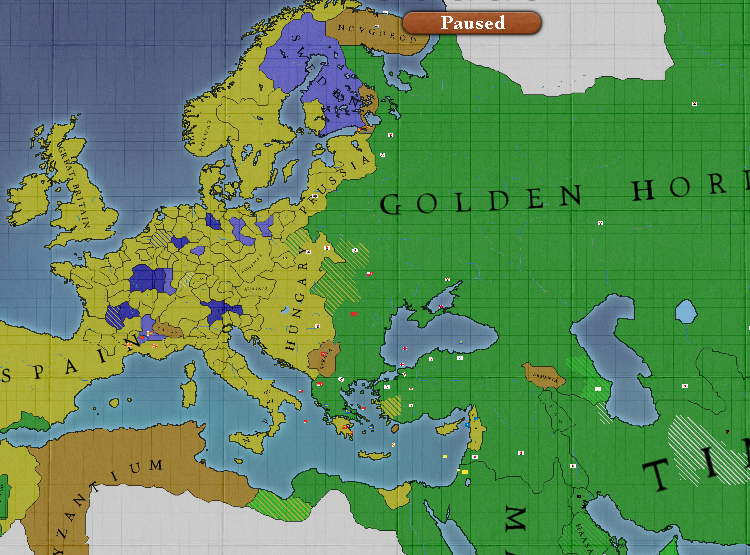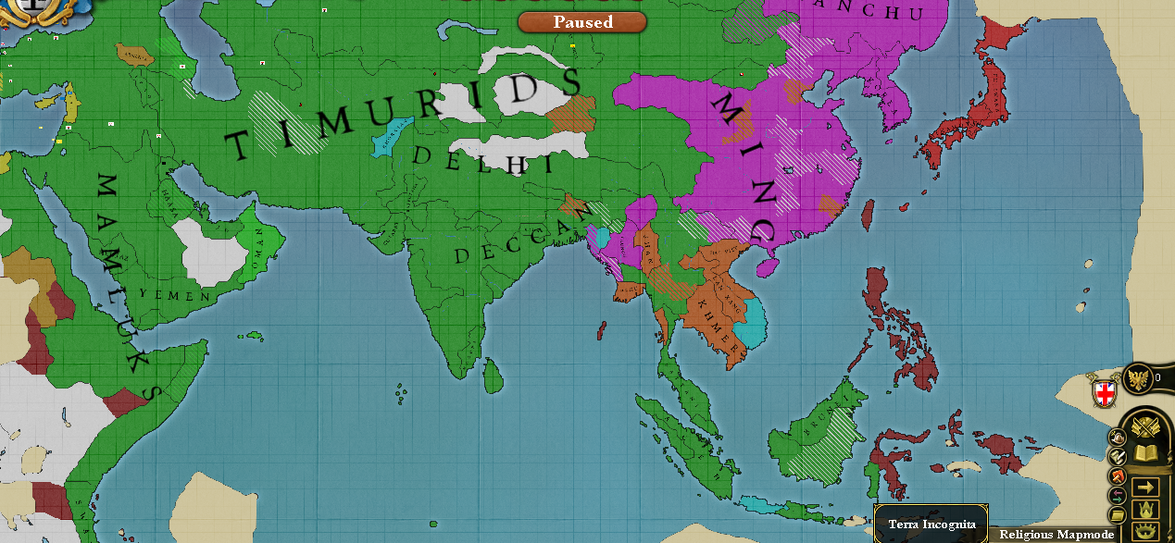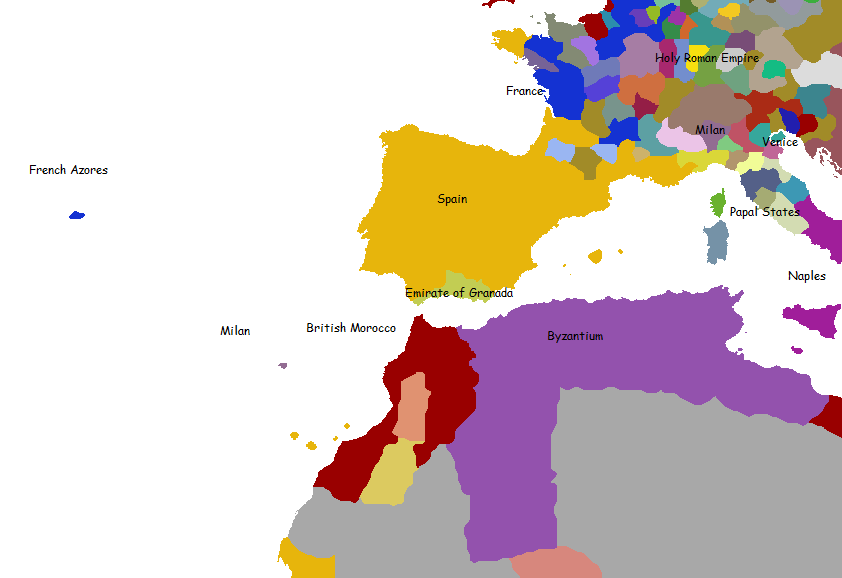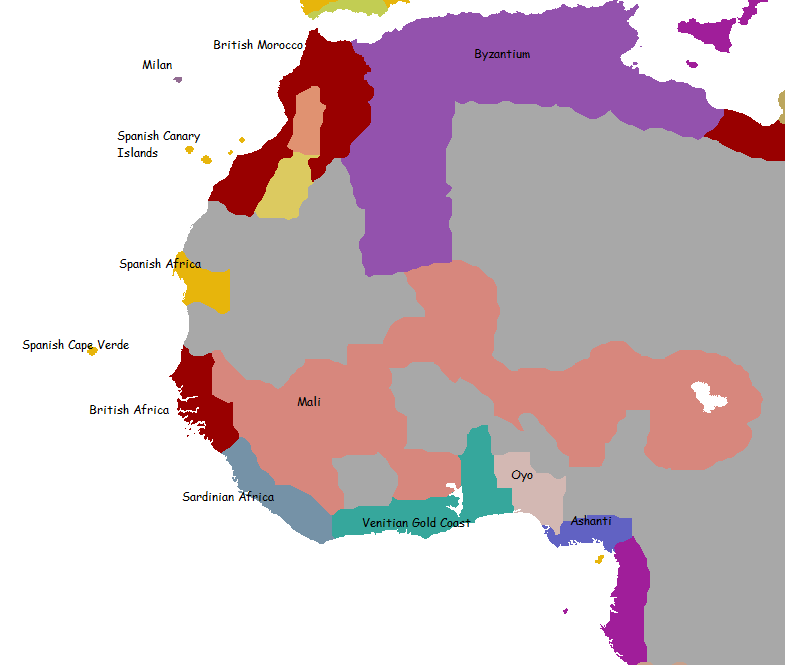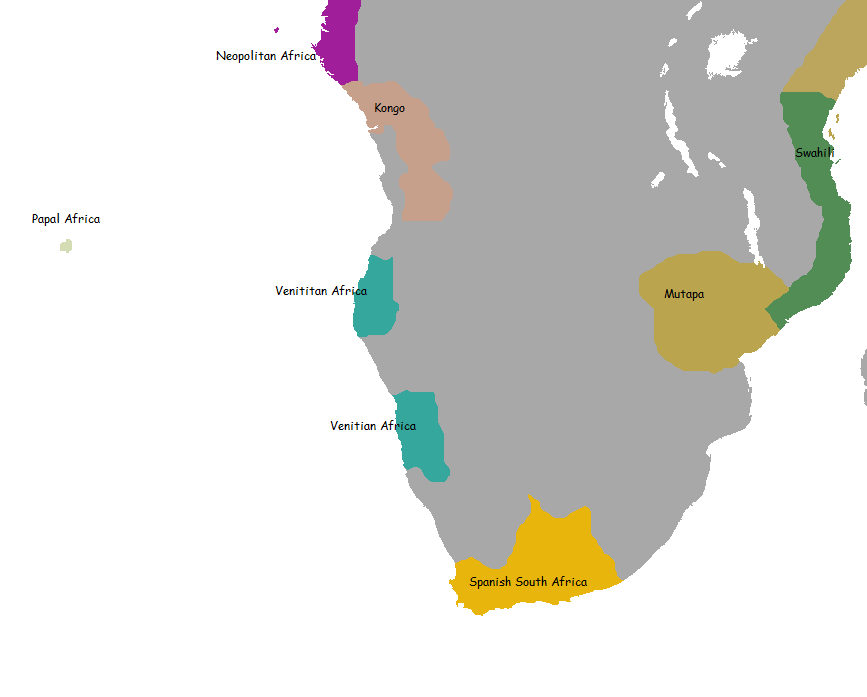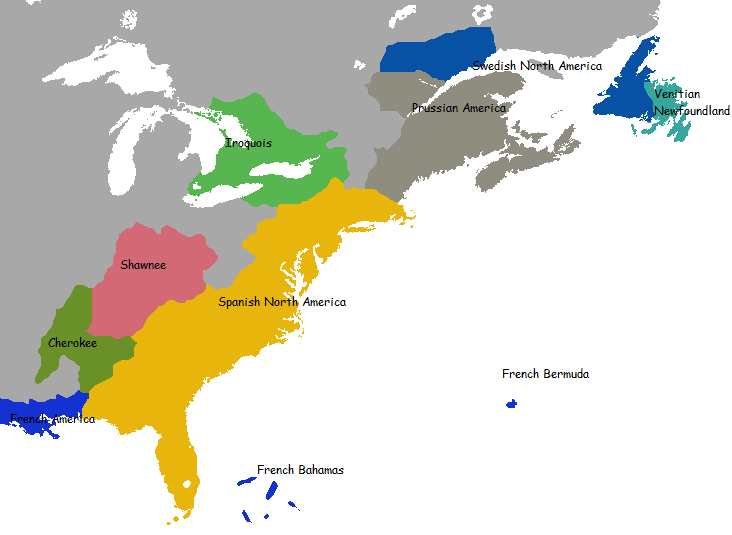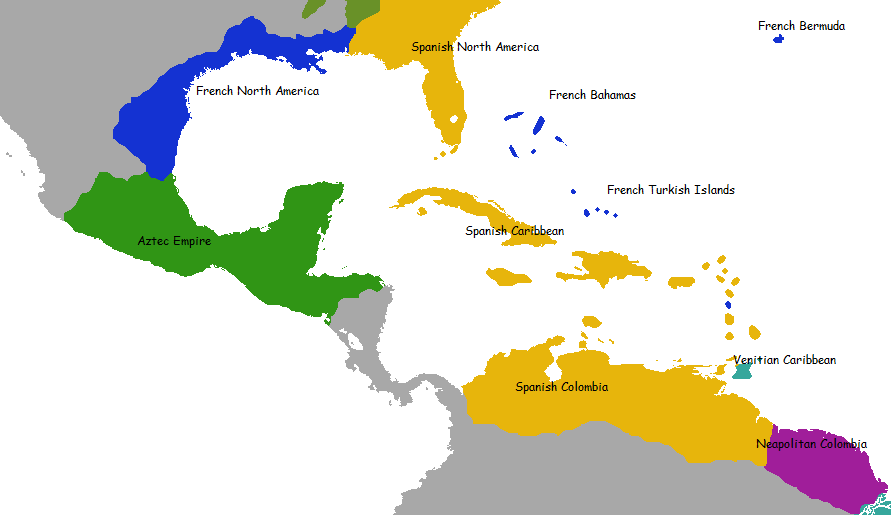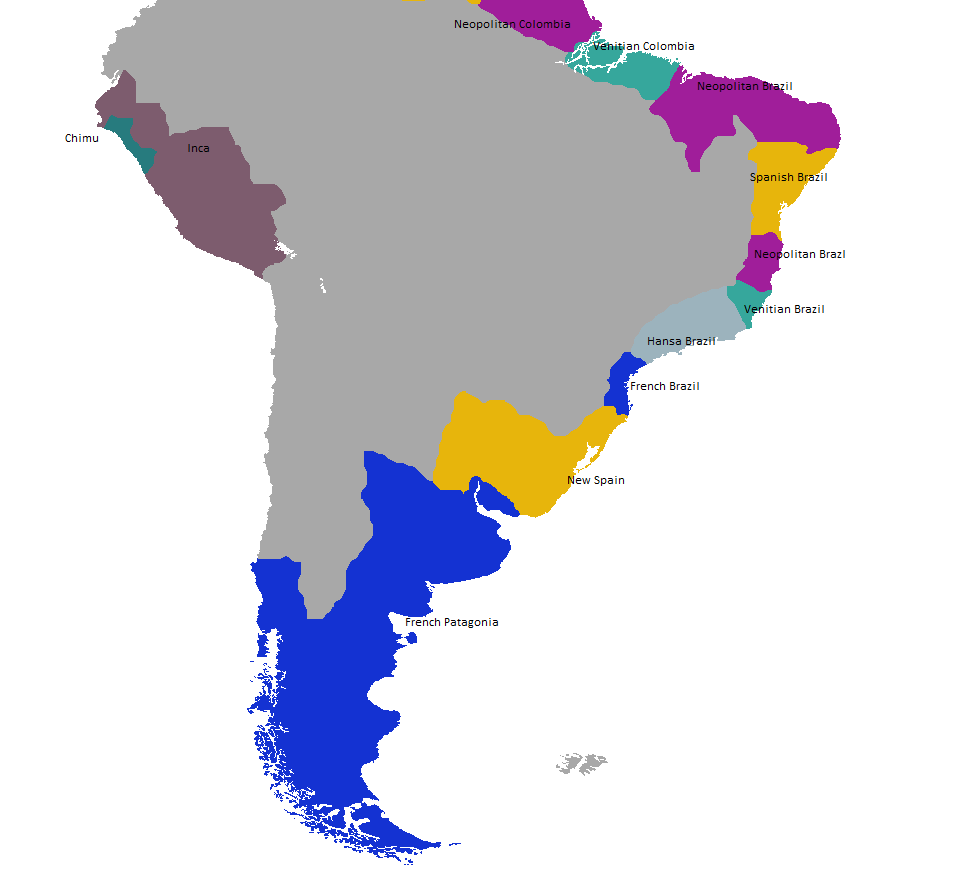The Holy Roman Empire
The Holy Roman Empire is one of the oldest and most powerful establishments inside of Europe. The Holy Roman Empire was established in 962 A.D. by Otto The Great as he was crowned Emperor by the Papacy. Since then the Holy Roman Empire has had high and low points, the lowest of these points culminated in the late 14th century when disunity was rampant and infighting prevailed far more often than standing united against external threats and the mere notion of expanding the Empire seemed alien as more and more land were lost to powerful neighbors picking away at the old establishment. All this started to change in the year 1407 when the Holy Roman Empire under the wing of Bohemia began to reform itself and show off a distinct presence out to the world. Up until 1470 A.D. the Bohemians under the von Luxembourgs were able to give the Empire definitive form and successfully defend it against it's enemies near and far. When the von Luxembourgs died out inside Bohemia, the throne of Holy Roman Emperor was narrowly passed on to Burgundy.
From Burgundy the for nearly sixty years the Empire was safe. France was beaten in several wars and all was "well" in the world for the Empire. There was notable expansion in Italy and alliances were drawn up with Spain in order to protect the interests of the Empire, but when the Burgundians lost the throne to the Austrians who claimed they were being too soft against the Empire's enemies, the Burgundians collapsed. Unable to field their massive army, France invaded and decisively crushed them. Spain and Austria was of no help to Burgundy who fled inland to the lands of Brandenburg where they would remain for decades. Austria, far from bringing the Empire to it's height, tore it down to the ground again. After two Emperors who ruled for barely a decade the Electors were desperate to return to Burdundian rule, but found them broken and unable to sustain them. After an intense debate over possible successors, the throne was given back to Bohemia under the de Valois.
Under the de Valois the HRE would reach it's highest point in centuries. Many electors preferred Bavaria to the de Valois, who they viewed as an unnatural French influence over the Germanic Empire. This was shattered following the decisive defeat and destruction of France's power on the continent and the creation of nearly a dozen small states that nearly always joined the Holy Roman Empire for it's protection and in turn strengthened the Empire. The de Valois also dismantled the Austrian Empire, which they viewed as a failed experiment that should never again rise to a position of dominance. The de Valois of Bohemia are nominal allies of the Genghisids inside the Golden Horde, but they would rather not lose the Hungarian and Prussian buffer states protecting the Empire from the largest and most powerful nation in the world. That said, Ludvik has shown that he is not enthusiastic about eradicating nations because they choose another faith and for that reason many plan to depose the de Valois with the Bavarians.
List of Holy Roman Emperors:
This is the land currently accepted to be a part of the Holy Roman Empire:
This is an overview of the Holy Roman Empire:
There are well over 100 territories under the rule of the Holy Roman Empire and exactly 67 nations that are a part of the Empire.
At the head of the Empire we have the Holy Roman Emperor which is currently Ludvik de Valois of Bohemia, he commands an army of 137,000 men making his army the fourth largest in the world behind only that of Spain, divided across entire continents, the Timurid Empire, and the Golden Horde, the strongest Empire in the World. Bohemia has direct control over 13 provinces and is a Feudal Monarchy, which is currently selecting itself to continue it's role as Holy Roman Emperor.
Next we have the Electors which hold say over the selection of the next Holy Roman Emperor. These Electors are Bohemia, Cologne, Mainz, Saxony, Tirol, Trier, and Pisa making a collection of seven states. At the head of Cologne we have Archbishop Gebhard II. Gebhard commands an army of 6000 men and rules over two territories. Currently, Gebhard is backing the Kingdom of Bavaria to succeed Ludvik de Valois when he passes.
The Archbishop of Mainz is Emmerich Joeseph. Currently Emmerich commands no army having no men to call his own. Emmerich Joseph has just one province to call his own, Mainz. Currently, Emmerich Joeseph is backing the Kingdom of Bavaria to succeed Ludvik when he meets his untimely demise.
The King of Saxony is Wolfgang II von Welf. Currently Wolfgang commands an army of 3000 men and is stationed in just one territory to call his own, and that would be Leipzig. The King of Saxony's government is an administrative Government. Also, the Kingdom of Saxony is backing the Kingdom of Bavara should Ludvik pass.
The Kingdom of Tirol is lead by Sigmund Franz von Wettin. Unlike the other electors, the Kingdom of Tirol is not Catholic, but Protestant. The fact that the Kingdom is a heretical nation rather than one of the true faith, and that it is an elector no less, is unsettling to the archbishops who think that Tirol should be exterminated or converted. Ludvik, so far, has been a kind and proven friend to Sigmund Franz von Wettin as well as his Kingdom in Tirol. Not to mention removing Tirol would mean going against the von Wettins which have a long history within the Empire. Currently Sigmund commands an admirable about of troops numbering 11,000 men. Tirol is an Administrative Monarchy and despite the kindness the de Valois have bestowed upon them, wishes to become the Holy Roman Emperor themselves following Ludvik's passing. Tirol controls only three provinces.
The Archbishop of Trier is commanded by archbishop Jakob. Jakob has a small army of 2000 men. He controls only one province, Trier. Like all archbishops, Jakob promotes the ascent of the Kingdom of Bavaria and the deposition of the friend of the heretics inside of Bohemia.
The Kingdom of Pisa is centered in Parma. The Kingdom is an administrative monarchy and is alone among the electors to be supporting a non-HRE nation to take on the title of Holy Roman Emperor in order to not only increase the size of the Empire, but also take an aggressive stance against the Genghisids, which the Kings of Pisa in Parma view as a threat to all of Christiandom and a threat that must be destroyed, or at least neutralized. Also, the elector from Parma is the only women to ever hold the position inside the entire history of the Empire. Currently, the Queen of Pisa is Gabrielle Maria II Viscounti and she controls an army of 3000 men.
After these seven there are the remaining sixty members of the Empire, they are divided into three groups: The Archbishoprics, The Republics, and The Monarchies
Kingdoms:
The [Feudal] Kingdom of Riga, Ruled by King Siegfried II Gediminai
The [Administrative] Kingdom of Poland, Ruled by King Henryk Premyslovci.
The [Administrative] Kingdom of Kurland, Ruled by King Ernest Johann Gediminai
The [Administrative] Kingdom of Alencon, Ruled by King Gaston II de Valois
The [Administrative] Kingdom of Burgundy, Ruled by King Philippe IV
The [Administrative] Kingdom of Corsica, Ruled by King Ericcu Ghjilormu III Paoli
The [Administrative] Kingdom of Nevers, Ruled by King Jean d'Escoubleau
The [Administrative] Kingdom of Normandy, Ruled by King Charles II de Anjou
The [Administrative] Kingdom of Orleans, Ruled by King Henri Alexandre de Penthievre
The [Administrative] Kingdom of Ansbach, Ruled by King Ludvik de Valois (under Bohemia)
The [Administrative] Kingdom of Bavaria, Ruled by King Theodor Askanier
The [Administrative] Kingdom of Brunswick, Ruled by King Karl II Wilhelm Askanier
The [Administrative] Kingdom of Austria, Ruled by King Franz Karl Garbade
The [Administrative] Kingdom of Hesse, Ruled by King Wilhelm V von Hessen
The [Administrative] Kingdom of Cleves, Ruled by King Adolf II van Lotharingen
The [Administrative] Kingdom of Saxe-Lauenberg Ruled by King Franz-Otto
The [Administrative] Kingdom of Lorraine, Ruled by King Charles III de Metz
The [Administrative] Kingdom of Messen, ruled by King Karl II Wilhelm Askanier (PU with Brunswick)
The [Administrative] Kingdom of Mecklenburg, Ruled by King Adolf Fredrick von Mecklenburg
The [Administrative] Kingdom of Oldenburg, Ruled by King Johann XV Friedrich Lammers
The [Administrative] Kingdom of Palatine, Ruled by King Christoph von Holstein-Gottorp
The [Administrative] Kingdom of Pomerania, Ruled by King Martin Strelows
The [Administrative] Kingdom of Silesia, Ruled by King Jan Krystian Hoppe
The [Administrative] Kingdom of Styria, Ruled by King Ernest III
The [Administrative] Kingdom of Thuringia, Ruled by King Frederich Wilhelm von Wettin
The [Administrative] Kingdom of Ulm, Ruled by King Gottfried II Shaluyn
The [Administrative] Kingdom of Wurttemberg, Ruled by King Ludwig IV von Wittelsbach
The [Administrative] Kingdom of Aquila, Ruled by King Pagano III Garbade
The [Administrative] Kingdom of Ferrara, Ruled by King Ippolito Montario
The [Administrative] Kingdom of Mantua, Ruled by King Rodolfo d'Este
The [Administrative] Kingdom of Milan, Ruled by King Francesco Paoli
The [Administrative] Kingdom of Modena, Ruled by King Alfonso Montecuccoli
The [Administrative] Kingdom of Parma, Ruled by King Philippo Sforza
The [Administrative] Kingdom of Urbino, Ruled by King Giovanni Maria de Montefeltro
The [Administrative] Kingdom of Brabant, Ruled by King Philippe IV de Valois
The [Administrative] Kingdom of Friesland, Ruled by King Ernest Casimir III van Henegouwen
The [Administrative] Kingdom of Luxembourg, Ruled by King Joachim Hoscheit
The [Administrative] Kingdom of Glere, Ruled by King Adolf Askanier
The [Administrative] Kingdom of Hainut, Ruled by King Jean III de Valois
The [Administrative] Kingdom of Holland, Ruled by King Adolf IV van Lotharingen
The [Administrative] Kingdom of Bar, Ruled by King Louis III Askanier
The [Administrative] Kingdom of Savoy, Ruled by Filibetro Luserno
The [Administrative] Duchy of Baden, Ruled by Duke Ludwig von Wittelsbach (vassal of Bohemia)
The [Administrative] Duchy of Berry, Ruled by Duke Francois de Montford (vassal of Bohemia)
The Republics
The [Administrative] Republic of Hansa, Ruled by Doge Oskar Franheim
The [Administrative] Republic of Aachen, Ruled by Syndac Gottschalk Zebnitsche
The [Administrative] Republic of Frankfurt, Ruled by Syndac Markus Eins
The [Administrative] Republic of Genoa, Ruled by Doge Camillo Senarega
The [Administrative] Republic of Switzerland, Ruled by Syndac Frederic Sporri
The [Administrative] Republic of Siena, Ruled by Doge Innocenzo Galilei
The Noble Republic of Tuscany, Ruled by Prince Salvestro Botta-Adorno
The Archbishoprics
The Archbishopric of Liege, Ruled by Archbishop Erard
The Archbishopric of Wurzburg, Ruled by Archbishop Johann Philippe
The Archbishopric of Luneburg, Ruled by Archbishop Otto III
The Archbishopric of Magdeburg, Ruled by Archbishop Ernest Ahrenkiel
The Archbishopric of Bremen, Ruled by Archbishop Gottfried III
The Archbishopric of Munster, Ruled by Archbishop Adolf II
The Archbishopric of Augsburg, ruled by Archbishop Baldwin
The Archbishopric of Alsace, Ruled by Archbishop Leopold
The Archbishopric of Utrecht, Ruled by Archbishop Filips
Most of the Holy Roman Empire is Catholic, but there are exceptions. Tirol, Bar, Cleves, Luneburg, and Brabant are Protestant. Brabant is the defender of the Portestant faith while Tirol is one of only seven out of sixty-seven nations within the Empire to be an elector. Luneburg serves as the premiere authority for the Protestant faith within the Empire, akin to the Papacy for the Catholic Church. Lorraine, Frankfurt, and Meissen are reformed states within the Empire. They answer to the Papacy inside of Avignon, who is also reformed but not part of the Empire itself. Savoy is the only state within the Empire to be Orthodox and commit itself to the Patriarch of Constantinople. Since the Patriarch has fled to Africa, this is a misnomer.
In addition to the 67 nations mentioned there are a few nations which have a minor say inside the affairs of the Holy Roman Empire. Venice, France, Spain, Hungary, Prussia, and the United Kingdom all control territory within the Empire without being a part of the Holy Roman Empire.
Also, over time, many names have become misnomers. Mantua is in Brescia, Ulm is in Wurttemberg, Burgundy is in Brandenburg, Parma is in Cremona, Pisa is in Parma, Wurttemberg is Konstanz, and other such nations have shifted over time.


